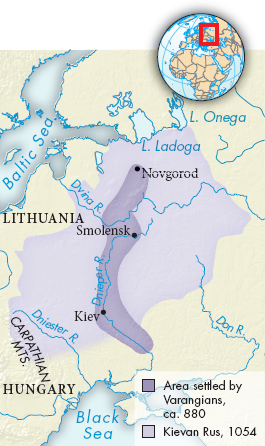Slavs and Vikings in Eastern Europe
Vikings also brought change in eastern Europe, which was largely populated by Slavs. In antiquity the Slavs lived in central Europe. With the start of the mass migrations of the late Roman Empire, the Slavs moved in different directions and split into what historians later identified as three groups: West, South, and East Slavs.
The group labeled the West Slavs included the Poles, Czechs, Slovaks, and Wends. The South Slavs, comprising peoples who became the Serbs, Croats, Slovenes, Macedonians, and Bosnians, migrated southward into the Balkans. In the seventh century, Slavic peoples of the west and south created the state of Moravia along the banks of the Danube River. By the tenth century, Moravia’s residents were Roman Christian, along with most of the other West and South Slavs. In the Balkans, the Serbs accepted Orthodox Christianity, while the Croats became Roman Christian.

Between the fifth and ninth centuries, the eastern Slavs moved into the vast areas of present-
In the ninth century, the Vikings appeared in the lands of the eastern Slavs. Called Varangians in the old Russian chronicles, the Vikings were interested primarily in gaining wealth through plunder and trade, and the opportunities were good. Moving up and down the rivers, they soon linked Scandinavia and northern Europe to the Black Sea and to the Byzantine Empire’s capital at Constantinople. They raided and looted the cities along the Caspian Sea several times in the tenth century, taking booty and slaves, which they then sold elsewhere; thus, raiding turned into trading, and the Scandinavians later established settlements, intermarried, and assimilated with Slavic peoples.
To increase and protect their international commerce and growing wealth, the Vikings declared themselves the rulers of the eastern Slavs. According to tradition, the semi-
Oleg and his clansmen quickly became assimilated into the Slavic population, taking local wives and emerging as the noble class. Missionaries of the Byzantine Empire converted the Vikings and local Slavs to Eastern Orthodox Christianity, accelerating the unification of the two groups. Thus, the rapidly Slavified Vikings left two important legacies for the future: in about 900 they created a loose unification of Slavic territories, Kievan Rus, under a single ruling prince and dynasty, and they imposed a basic religious unity by accepting Orthodox Christianity, as opposed to Roman Catholicism, for themselves and the eastern Slavs.
Even at its height under Great Prince Iaroslav (YAHR-
The boyars were descendants of the original Viking warriors, and they also held their lands as free and clear private property. Although the boyars normally fought in princely armies, the customary law declared that they could serve any prince they wished. The ordinary peasants were also truly free. They could move at will wherever opportunities were greatest. In short, fragmented princely power, private property, and personal freedom all went hand in hand.